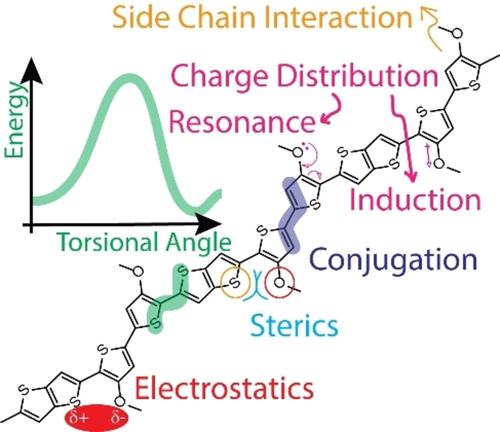当前位置:
X-MOL 学术
›
ChemPlusChem
›
论文详情
Our official English website, www.x-mol.net, welcomes your feedback! (Note: you will need to create a separate account there.)
Conformational Analysis of Conjugated Organic Materials: What Are My Heteroatoms Really Doing?
ChemPlusChem ( IF 3.4 ) Pub Date : 2024-04-10 , DOI: 10.1002/cplu.202300773 Karl J. Thorley 1 , Christian B. Nielsen 2
ChemPlusChem ( IF 3.4 ) Pub Date : 2024-04-10 , DOI: 10.1002/cplu.202300773 Karl J. Thorley 1 , Christian B. Nielsen 2
Affiliation

|
Organic semiconductor small molecules and polymers often incorporate heteroatoms into their chemical structures to affect the electronic properties of the material. A particular design philosophy has been to use these heteroatoms to influence torsional potentials, since the overlap of adjacent π‐orbitals is most efficient in planar systems and is critical for charge delocalization in these systems. Since these design rules became popular, the messages from the earlier works have become lost in a sea of reports of “conformational locks”, where the non‐covalent interactions have relatively small contributions to planarizing torsional potentials. Greater influences can be found in the stabilization by extended conjugation, consideration of steric repulsion, and the interactions involving solubilizing chains and neighboring molecules or polymer chains in condensed phases.
中文翻译:

共轭有机材料的构象分析:我的杂原子到底在做什么?
有机半导体小分子和聚合物通常将杂原子纳入其化学结构中以影响材料的电子特性。一种特殊的设计理念是使用这些杂原子来影响扭转势,因为相邻 π 轨道的重叠在平面系统中最有效,并且对于这些系统中的电荷离域至关重要。自从这些设计规则变得流行以来,早期作品中的信息已经消失在大量“构象锁”的报告中,其中非共价相互作用对平面化扭转势的贡献相对较小。通过延长共轭、考虑空间排斥以及涉及增溶链和凝聚相中邻近分子或聚合物链的相互作用,可以发现更大的影响。
更新日期:2024-04-10
中文翻译:

共轭有机材料的构象分析:我的杂原子到底在做什么?
有机半导体小分子和聚合物通常将杂原子纳入其化学结构中以影响材料的电子特性。一种特殊的设计理念是使用这些杂原子来影响扭转势,因为相邻 π 轨道的重叠在平面系统中最有效,并且对于这些系统中的电荷离域至关重要。自从这些设计规则变得流行以来,早期作品中的信息已经消失在大量“构象锁”的报告中,其中非共价相互作用对平面化扭转势的贡献相对较小。通过延长共轭、考虑空间排斥以及涉及增溶链和凝聚相中邻近分子或聚合物链的相互作用,可以发现更大的影响。



























 京公网安备 11010802027423号
京公网安备 11010802027423号